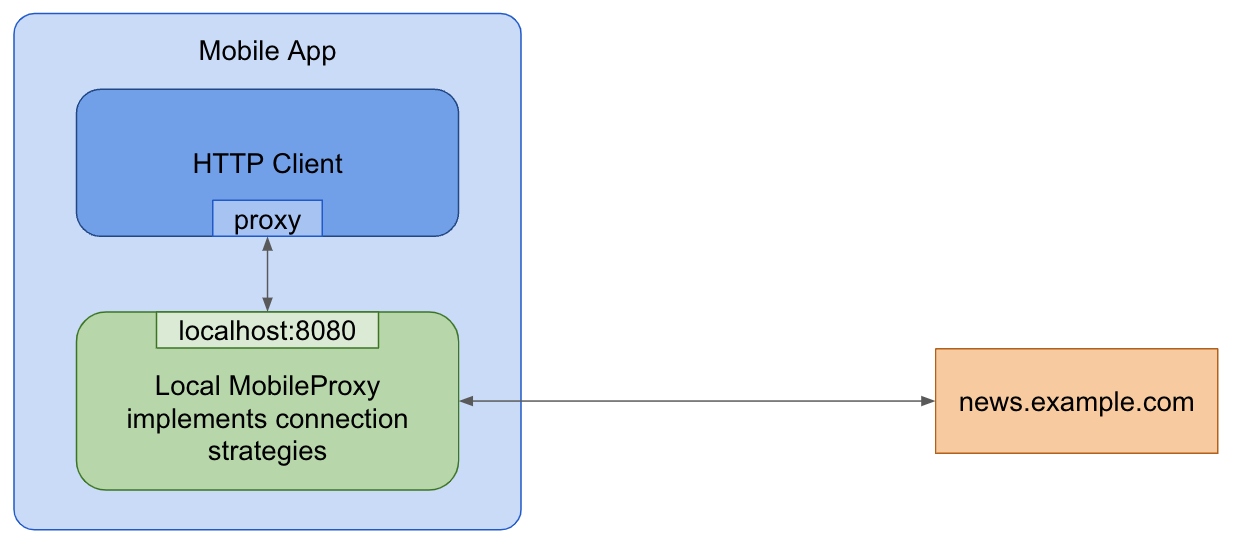En este documento, se describe cómo integrar el SDK de Outline en tus aplicaciones
para dispositivos móviles, con un enfoque en la biblioteca MobileProxy para simplificar la administración del proxy
local.
MobileProxy es una biblioteca basada en Go diseñada para optimizar la integración de las
funciones del proxy en apps para dispositivos móviles. Utiliza Go
para dispositivos móviles con el objetivo de generar bibliotecas para dispositivos móviles, lo que te permite
configurar las bibliotecas de redes de tu app para enrutar el tráfico a través de un proxy
local.
App sin MobileProxy

App con MobileProxy

Paso 1: Compila las bibliotecas MobileProxy para dispositivos móviles
Usa gomobile para compilar el código de Go en bibliotecas para iOS y Android.
Clona el repositorio del SDK de Outline:
git clone https://github.com/Jigsaw-Code/outline-sdk.git cd outline-sdk/xCompila los objetos binarios de Go para dispositivos móviles con
go build:go build -o "$(pwd)/out/" golang.org/x/mobile/cmd/gomobile golang.org/x/mobile/cmd/gobindCómo agregar compatibilidad con Psiphon
Puedes agregar compatibilidad con el uso de la red de Psiphon siguiendo estos pasos adicionales:
- Comunícate con el equipo de Psiphon para obtener un archivo de configuración que te otorgue acceso a su red (lo que puede requerir la celebración de un contrato).
- Agrega el archivo de configuración de Psiphon a la sección
fallbackde tu archivo de configuraciónSmartDialer. Crea el MobileProxy con la marca
-tags psiphon:go build -tags psiphon -o "$(pwd)/out/" golang.org/x/mobile/cmd/gomobile golang.org/x/mobile/cmd/gobind
La marca
-tags psiphones obligatoria porque la base de código de Psiphon tiene una licencia de GPL, que puede imponer restricciones de licencia en tu propio código. Te recomendamos que obtengas una licencia especial de Psiphon.Genera bibliotecas para dispositivos móviles y agrégalas a tu proyecto:
Android
PATH="$(pwd)/out:$PATH" gomobile bind -ldflags='-s -w' -target=android -androidapi=21 -o "$(pwd)/out/mobileproxy.aar" github.com/Jigsaw-Code/outline-sdk/x/mobileproxyEn Android Studio, selecciona File > Import Project… para importar el paquete
out/mobileproxy.aargenerado. Para obtener más ayuda, consulta la sección Building and deploying to Android del artículo sobre Go para dispositivos móviles.iOS
PATH="$(pwd)/out:$PATH" gomobile bind -ldflags='-s -w' -target=ios -iosversion=11.0 -o "out/mobileproxy.xcframework" github.com/Jigsaw-Code/outline-sdk/x/mobileproxyArrastra el paquete
out/mobileproxy.xcframeworkal proyecto de Xcode. Para obtener más ayuda, consulta la sección Building and deploying to iOS del artículo sobre Go para dispositivos móviles.
Paso 2: Ejecuta MobileProxy
Inicializa e inicia el proxy local MobileProxy en el entorno de ejecución de tu app.
Puedes usar una configuración de transporte estático o el proxy inteligente para
la selección de una estrategia dinámica.
Configuración de transporte estático: Usa la función
RunProxycon una dirección local y una configuración de transporte.Android
import mobileproxy.* val dialer = StreamDialer("split:3") // Use port zero to let the system pick an open port for you. val proxy = Mobileproxy.runProxy("localhost:0", dialer) // Configure your networking library using proxy.host() and proxy.port() or proxy.address(). // ... // Stop running the proxy. proxy.stop()iOS
import Mobileproxy let dialer = MobileproxyStreamDialer("split:3") // Use port zero to let the system pick an open port for you. let proxy = MobileproxyRunProxy("localhost:0", dialer) // Configure your networking library using proxy.host() and proxy.port() or proxy.address(). // ... // Stop running the proxy. proxy.stop()Smart Proxy: Smart Proxy selecciona de forma dinámica estrategias de DNS y TLS en función de dominios de prueba especificados. Debes especificar la estrategia de configuración en formato YAML (ejemplo).
Android
val testDomains = Mobileproxy.newListFromLines("www.youtube.com\ni.ytimg.com") val strategiesConfig = "..." // Config YAML. val dialer = Mobileproxy.newSmartStreamDialer(testDomains, strategiesConfig, Mobileproxy.newStderrLogWriter()) // Use port zero to let the system pick an open port for you. val proxy = Mobileproxy.runProxy("localhost:0", dialer) // Configure your networking library using proxy.host() and proxy.port() or proxy.address(). // ... // Stop running the proxy. proxy.stop()iOS
import Mobileproxy var dialerError: NSError? let testDomains = MobileproxyNewListFromLines("www.youtube.com\ni.ytimg.com") let strategiesConfig = "..." // Config YAML. let dialer = MobileproxyNewSmartStreamDialer( testDomains, strategiesConfig, MobileproxyNewStderrLogWriter(), &dialerError ) var proxyError: NSError? // Use port zero to let the system pick an open port for you. MobileproxyRunProxy("localhost:0", dialer, &proxyError) // Configure your networking library using proxy.host() and proxy.port() or proxy.address(). // ... // Stop running the proxy. proxy.stop()
Paso 3: Configura clientes HTTP y bibliotecas de redes
Configura tus bibliotecas de redes para que usen el puerto y la dirección del proxy local.
HttpClient Dart o Flutter
Configura el proxy con
HttpClient.findProxy.
HttpClient client = HttpClient();
client.findProxy = (Uri uri) {
return "PROXY " + proxy.address();
};
OkHttp (Android)
Configura el proxy con
OkHttpClient.Builder.proxy.
val proxyConfig = Proxy(Proxy.Type.HTTP, InetSocketAddress(proxy.host(), proxy.port()))
val client = OkHttpClient.Builder().proxy(proxyConfig).build()
JVM (Java y Kotlin)
Configura el proxy para usarlo con propiedades del sistema:
System.setProperty("http.proxyHost", proxy.host())
System.setProperty("http.proxyPort", String.valueOf(proxy.port()))
System.setProperty("https.proxyHost", proxy.host())
System.setProperty("https.proxyPort", String.valueOf(proxy.port()))
WebView de Android
Aplica la configuración de proxy a todas las vistas web de tu aplicación con
la
biblioteca
androidx.webview:
ProxyController.getInstance()
.setProxyOverride(
ProxyConfig.Builder()
.addProxyRule(this.proxy!!.address())
.build(),
{}, // execution context for the following callback - do anything needed here once the proxy is applied, like refreshing web views
{} // callback to be called once the ProxyConfig is applied
)
WebView de iOS
A partir de iOS 17, puedes agregar una configuración de proxy a WKWebView usando su
propiedad
WKWebsiteDataStore:
let configuration = WKWebViewConfiguration()
let endpoint = NWEndpoint.hostPort(host: NWEndpoint.Host(proxyHost), port: NWEndpoint.Port(proxyPort)!)
let proxyConfig = ProxyConfiguration.init(httpCONNECTProxy: endpoint)
let websiteDataStore = WKWebsiteDataStore.default()
websiteDataStore.proxyConfigurations = [proxyConfig]
let webview = WKWebView(configuration: configuration)
Uso avanzado: Genera una biblioteca para dispositivos móviles personalizada
Para los casos de uso avanzados, puedes generar tus propias bibliotecas para dispositivos móviles:
- Crea una biblioteca de Go: Desarrolla un paquete de Go uniendo las funciones requeridas del SDK.
- Genera bibliotecas para dispositivos móviles: Usa
gomobile bindpara producir Android ARchives (AAR) y frameworks de Apple. Ejemplos: - Integra la biblioteca en tu app: Agrega la biblioteca generada a tu aplicación para dispositivos móviles.
